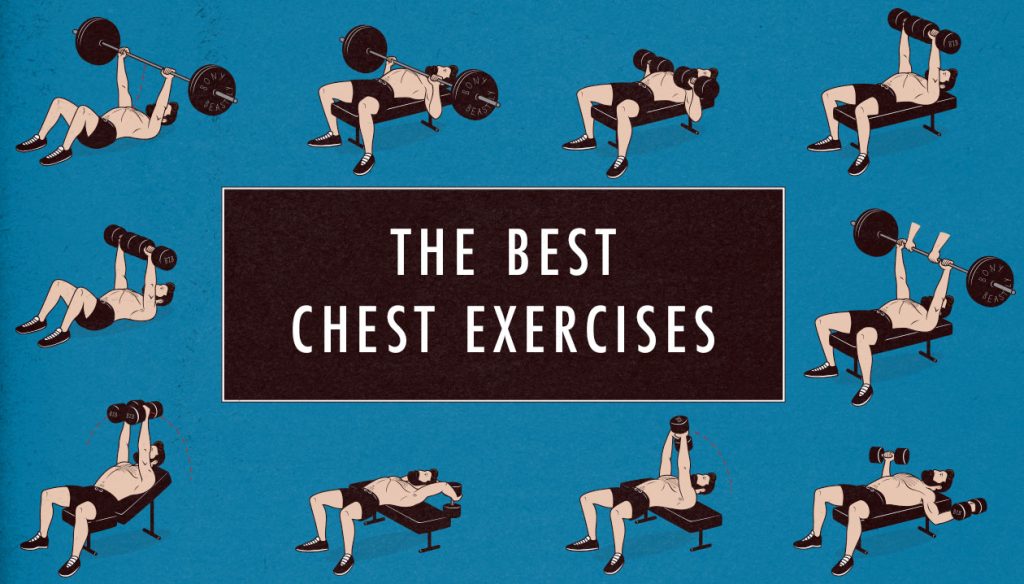
The Best Chest Exercises for Building Muscle
The three best chest exercises are the bench press, push-up, and dip. They work your pecs along with your front delts and triceps. That’s usually a good thing, but you need to make sure those other muscles aren’t taking over and hogging all the muscle growth.
One solution is to include some chest isolation exercises: the dumbbell fly, cable crossover, and pec deck machine. I recommend the dumbbell fly—I’ll explain why in a second—but they’re all great exercises.
You also need an exercise for your upper chest, such as an incline bench press. Every pressing exercise works your upper chest, but usually not hard enough to stimulate much muscle growth. It pays to include a lift that targets it directly.
Here’s how to combine all the best chest exercises into a proper chest workout.
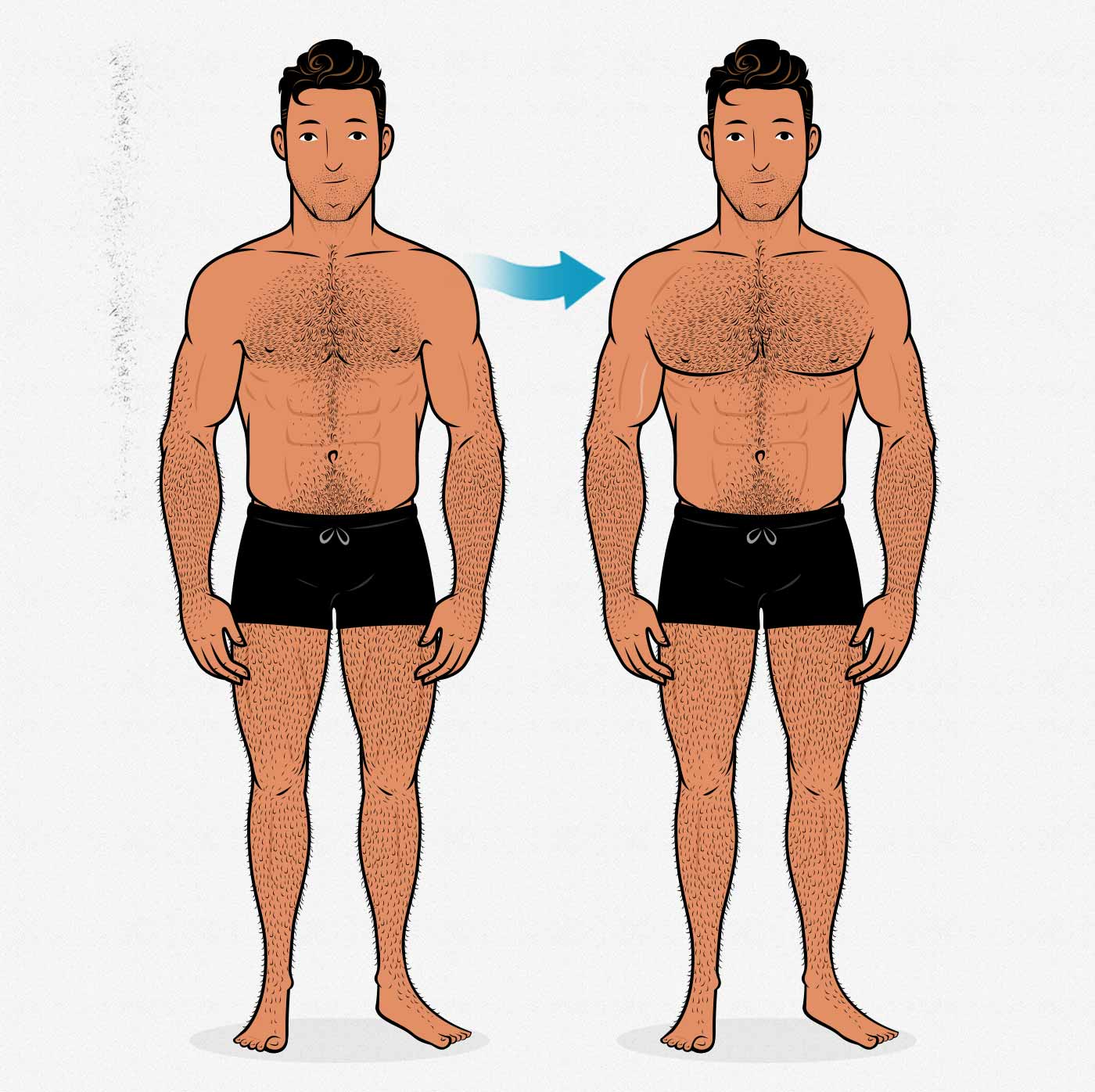
Introduction
You can build a bigger chest with a wide variety of chest exercises. If you don’t have a barbell, use dumbbells. If you don’t have dumbbells, do deficit push-ups. So as we go through these exercises, keep in mind that none of them are required. The point is to consider the pros and cons, then choose the exercises that suit you best.
But that doesn’t mean that building a bigger chest is easy. It can actually be quite hard, and it’s common for people to have a lot of trouble building a bigger chest, a lot of trouble building a bigger bench press. In our article on how to build a bigger chest, we went over the three principles that guarantee chest growth:
- Choose exercises where your chest the limiting factor, ensuring that it gets most of the growth stimulus. And if your upper chest is lagging, the same rule applies: choose lifts where your upper chest is the limiting factor.
- Challenge your chest under a deep stretch, improving how much muscle growth you stimulate with every set. As we’ll cover below, this can double your rate of muscle growth.
- Ensure that you’re achieving progressive overload, getting stronger over time, gradually lifting more weight or doing more repetitions. This includes eating enough protein and calories to recover and grow from your workouts.
If you can do these three things, you can build muscle with the barbell bench press, dumbbell bench press, push-up, chest fly, or dip. So let’s go through each exercise, talking about how to make sure that your chest is the limiting factor, that you’re working it under a deep stretch, and that you’re able to outlift yourself every week.
The Best Chest Exercises
The Bench Press
The bench press is a compound lift that has us lowering the barbell down to our chests, then pressing it back up using our chests, shoulders, and triceps. It’s considered one of the “big 3” weight training exercises, along with the squat and the deadlift.
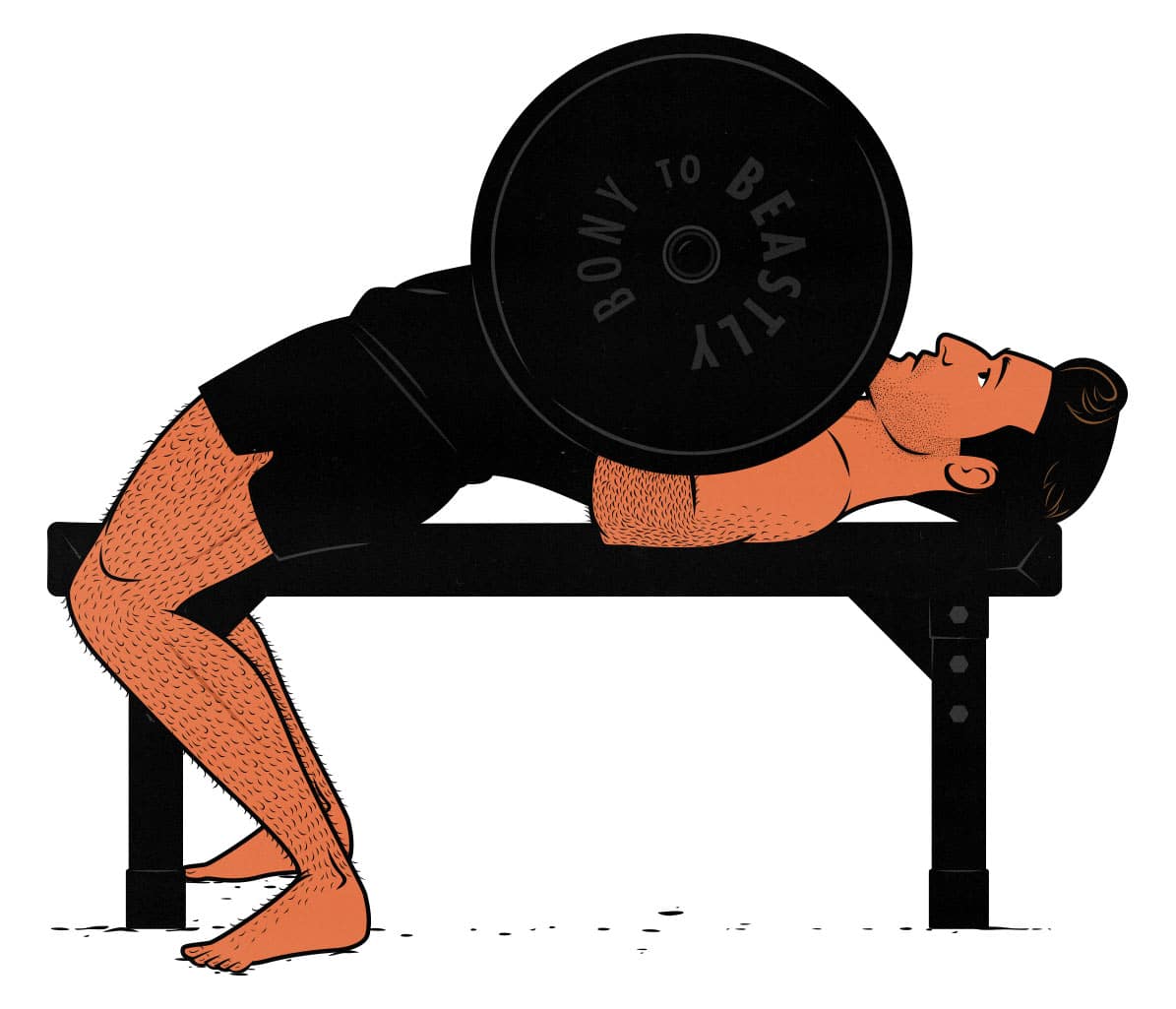
The bench press is also the most popular lift. It rose to popularity in the 50s when people saw how good it was at building bigger chests. And since then, powerlifters, bodybuilders, and the scientific literature all agree that the bench press is the best chest exercise. There are three reasons why it’s so good:
- The barbell bench press allows you to load up the bar with the heaviest weights, providing the most mechanical tension, which is the main driver of muscle growth.
- Muscle activation research (EMG) shows that it’s great at working your chest hard (study).
- It has a sticking point near the bottom of the range of motion, when your chest is under a deep stretch, which research shows is ideal for stimulating muscle growth (meta-analysis).
All of this combines to create a lift that’s absolutely perfect for building a bigger chest. But to remove all doubt, researchers then confirmed that a stronger bench press directly translates to bigger chest muscles, meaning that every pound you add to the bar is a reliable indicator that you’re building a bigger chest. (study).
In addition to being the best exercise for chest growth, the bench press also does a great job of strengthening your shoulders (which assist in the push), your triceps (which lock your arms out), and your entire back (which provides a stable platform). In fact, once you’re able to lift heavy enough, the weight of the barbell will even begin to strengthen the bones in your arms. This makes the bench press not only the best chest exercise, but also one of the best muscle-building lifts overall.
How to Bench for Chest Growth

The bench press is a great all-around exercise, and for most people, it naturally does a good job of bulking up the chest. But if you’re having trouble feeling your chest engaging, or if you’re noticing that your shoulders or triceps are outpacing your chest, then it can help to adjust your technique until your chest becomes the limiting factor. Here’s how to do that:
- Use a wider grip and flare your elbows. Grip the bar about 1.5 times as wide as your collarbones and flare your elbows to about 80 degrees. This will line up the pull angle with the biggest and strongest muscle fibres in your chest, allowing you to press more weight and gain more chest size (study). For some stockier lifters, this isn’t needed. But for us naturally skinny guys, it can really help.
- Use a parabolic bar path. When you lift the barbell off your sternum, first work to bring it above your nipples, putting the barbell in line with the strong fibres of your mid-chest, and then push it straight up from there (as shown in the illustration above). To do this, think “flare and push.” Again, this will increase your bench press strength as well as your chest growth.
- Lift in a moderate rep range. When you bench heavy (1–8 reps per set), your shoulders and triceps will fully engage. That’s not necessarily a problem, but it makes them more likely to become your limiting factor, taking emphasis away from your chest. If you want more chest growth, try benching in a more moderate rep range: 9–12 reps per set.
- Use a modest back arch. Using a sturdy arched position, with your shoulder blades pinched tight, puts your chest in a better position to push from, and it also makes the lift more challenging on your chest when it’s in a deep stretch. To quote Dr Layne Norton, “many bodybuilders think that arching your back is just a powerlifting move, but arching your lower back will actually help you maintain a neutral spine, keeping your back tight and protected as you press.”
- Vary your bench press routine. You can get great chest gains out of the bench press day after day, month after month, year after year—provided that you vary the rep ranges, the number of sets per workout, and the isolation lifts that you pair it with.
The Best Bench Press Variations

- Dumbbell bench press. The dumbbell bench press is a lighter bench press variation that puts more emphasis on the chest. This is because the weights aren’t held together by a barbell, forcing your chest to fight to bring the weights together. It won’t do as good of a job of bulking up your shoulders or triceps, which is why most people default to the barbell bench press, but if your goal is to build a bigger chest, the dumbbell bench press is a great alternative (study).
- Dumbbell floor press. If you have cranky shoulders or you’ve misplaced your bench, the floor press is a great exercise to build chest size and strength. Your range of motion is limited with the floor press, keeping your shoulders in a safe position. However, it also limits the stretch on your chest, which is why benching from a bench is a better default.
The Push-Up
Even though they’re often relegated to bodyweight and general fitness programs, push-ups remain one of the best exercises for gaining chest strength and size. Plus, any muscle you build from doing push-ups will translate perfectly to your bench press strength (study), making them the perfect accessory lift.
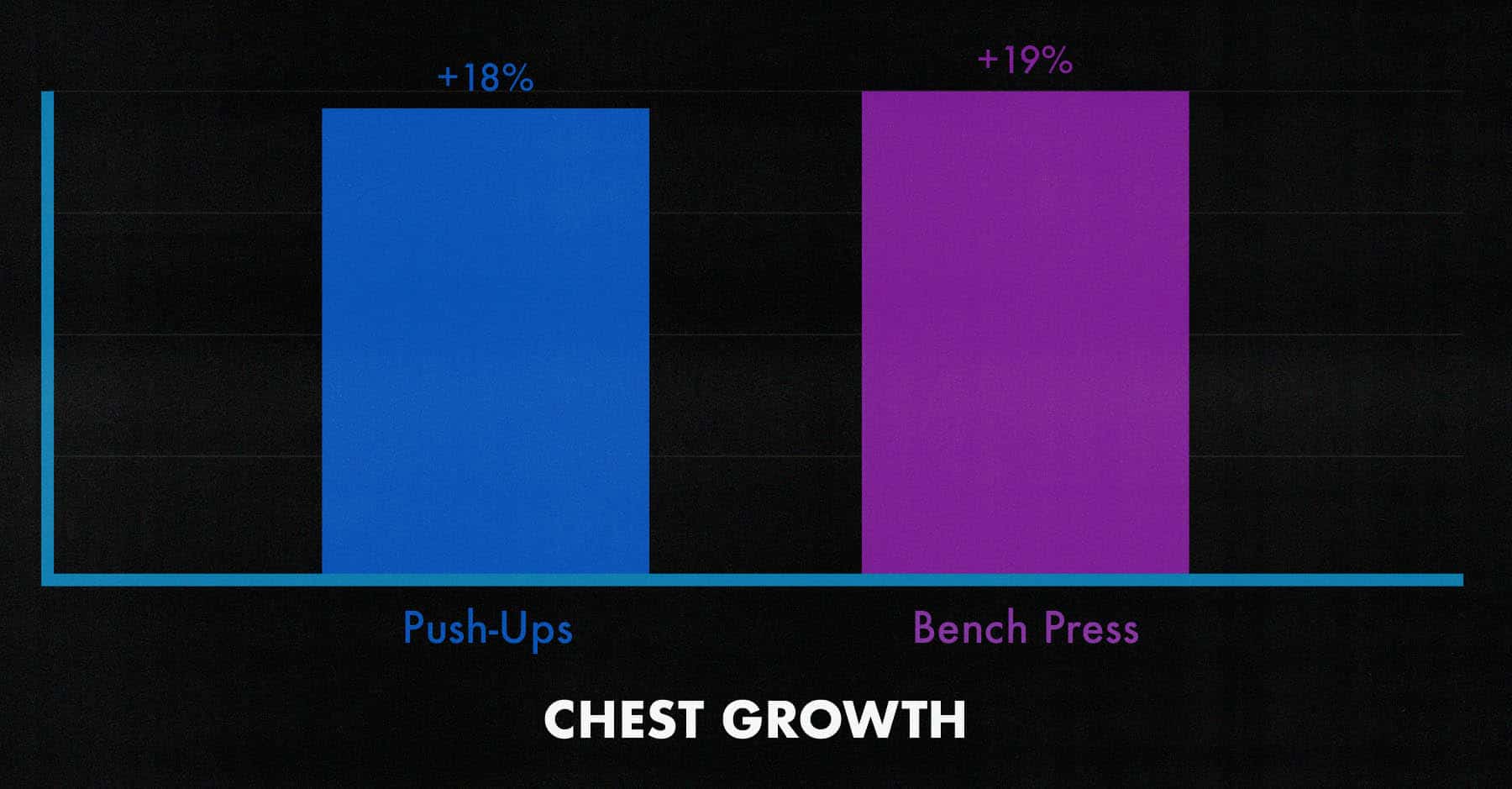
However, one of the best things about the push-up is how different they are from the bench press. To quote the hypertrophy research, Dr Brad Schoenfeld:
Maximal muscular adaptation can only be achieved by fully working all aspects of all the major muscles, and this can only be accomplished by training with a variety of exercises.
Brad Schoenfeld, PhD
So, oddly enough, one reason why push-ups are so valuable is that they’re a compound chest exercise that’s different from the bench press—a different range of motion, different arm angles, and a different line of push.
Push-ups have a couple of other notable benefits:
- Greater range of motion. You don’t need to keep your shoulder blades retracted while doing push-ups, giving you a larger range of motion at the top of the push, which bulks up your serratus anterior muscles (the muscles on top of your ribcage). This also helps you develop more versatile pressing strength.
- Push-ups are easy to do at home. Easygoing sets of push-ups on rest days will pump blood into your chest muscles, speeding up recovery. Harder sets of push-ups on rest days can count as a light chest workout. To get optimal chest growth, you’ll want to be stimulating your chest 2–3 times per week, but one of those workouts could be as simple as an at-home push-up workout.
How to Do Push-ups to Emphasize Chest Growth

- The setup: start in a plank position with your hands a little wider than shoulder-width apart, facing forward (as shown in the illustration). Put your body into a plank position by flexing your butt and abs and tucking your chin.
- The lower. Lower yourself down as far as you can go, flaring your elbows no more than 45 degrees. You may even be able to touch your chest to the ground. (If your nose hits the ground first, remember to tuck your chin.)
- The lift. Push the floor away, and keep pushing until your chest is fully contracted and your back is fully expanded. That extra range of motion, where you expand your back, is great for bulking up your serratus anterior muscles… which aren’t part of your chest, but they’ll add some nice size and strength to that same area.
Note for the strong: Once you can do more than around 30 push-ups in a row, they stop being good for gaining chest size and strength, becoming more of an endurance exercise. At this point, you’ll need to switch to a harder variation. The very best variation is the deficit push-up, but there are several effective push-up variations.
The Best Push-Up Variations for Your Chest

- Weighted push-ups/band push-ups: If you’re interested in gaining chest size and strength, these variations are the best, allowing you to make your push-ups progressively heavier as your chest gets bigger and stronger.
- Clap push-ups: If you can’t add weight to your push-up, make it more explosive instead. The principle here is simple: force=mass x acceleration, so if you can’t increase the mass you’re lifting, accelerate that mass faster. To do this exercise, start in the bottom position and push off from the ground explosively, trying to propel your upper body as far off the ground as possible. When your upper body leaves the ground, clap your hands, and then catch yourself before you break your nose.
- Deficit push-ups: the very best way to get more chest growth out of your push-ups is to enhance the stretch on your chest by raising your hands on push-up handles, weight plates, or speculative fiction novels.
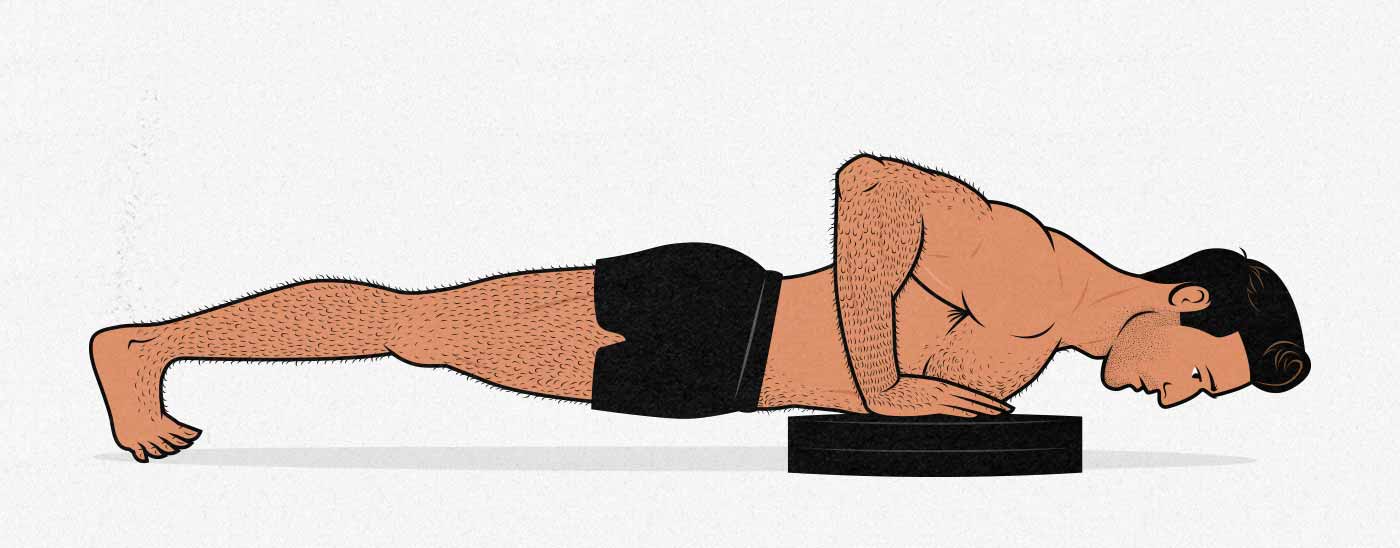
There are a million other push-up variations, but they aren’t very good at stimulating your chest. Yes, you could raise your feet, but that would shift the emphasis away from your chest and onto your shoulders, turning it into more of an incline bench press. So stick with push-ups, deficit push-ups, and weighted push-ups.
The Dumbbell Chest Fly
The dumbbell pec fly is a classic chest exercise and one of Arnold Schwarzenegger’s all-time favourites. What’s interesting is that as more research has come out, we’ve learned why it’s so good for building a bigger chest: because it works our chest maximally hard while it’s under the deepest stretch.
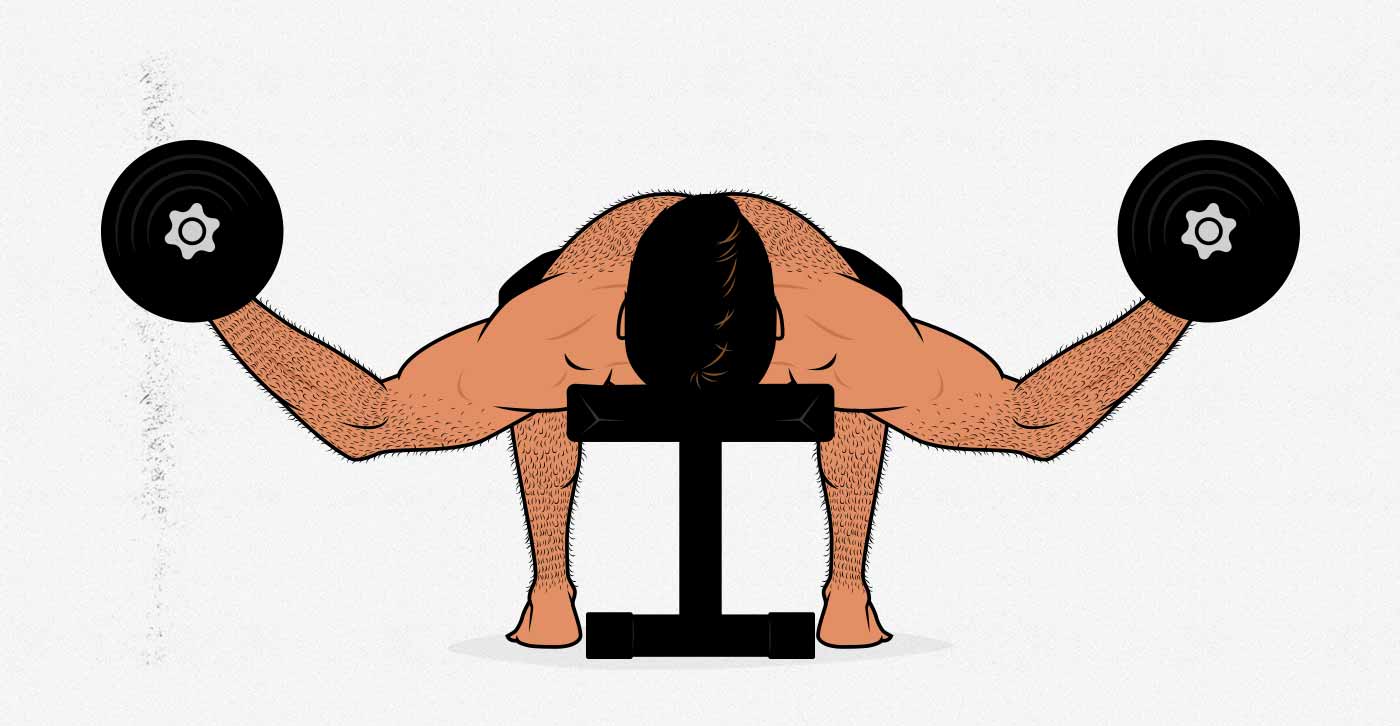
This deep part of the range of motion stimulates the most muscle growth, so having a lift that’s disproportionally hard at the bottom means that we’re investing all of our effort into the part of the lift that’s best for building muscle.
The dumbbell pec fly is great for isolating your chest muscles, it pairs perfectly with the bench press, and all you need are a pair of dumbbells, making it a great addition to any chest routine.
How to Do the Dumbbell Chest Fly

- The setup. Start by pressing the dumbbells into the starting position, and just like with the bench press, set your back with a small arch and drive your shoulder blades down into the bench behind you.
- The lower. Lower the weight down slowly and under control (2–3 seconds), letting your elbows bend freely, and feeling the tension on your chest as it stretches out. If you have good mobility in your shoulders, your elbows will finish slightly below your torso.
- The lift. Hug the weight back up until the weights are back in the starting position, focusing on squeezing your pecs.
The Machine Fly / Pec Deck Fly
The machine chest fly is the best chest exercise for keeping your muscles under constant tension throughout the entire range of motion. Is this important? Probably not. But it doesn’t hurt, either, and it may help a small amount. There’s a bit of research showing that keeping constant tension on our muscles can speed up muscle growth (study).
Another interesting feature of the machine fly is that it makes the weight easier for our shoulders to stabilize, shifting more emphasis to our chests (study). Plus, because the lift is so straightforward, you can focus purely on squeezing your pecs.
How to Do the Machine Chest Fly Exercise
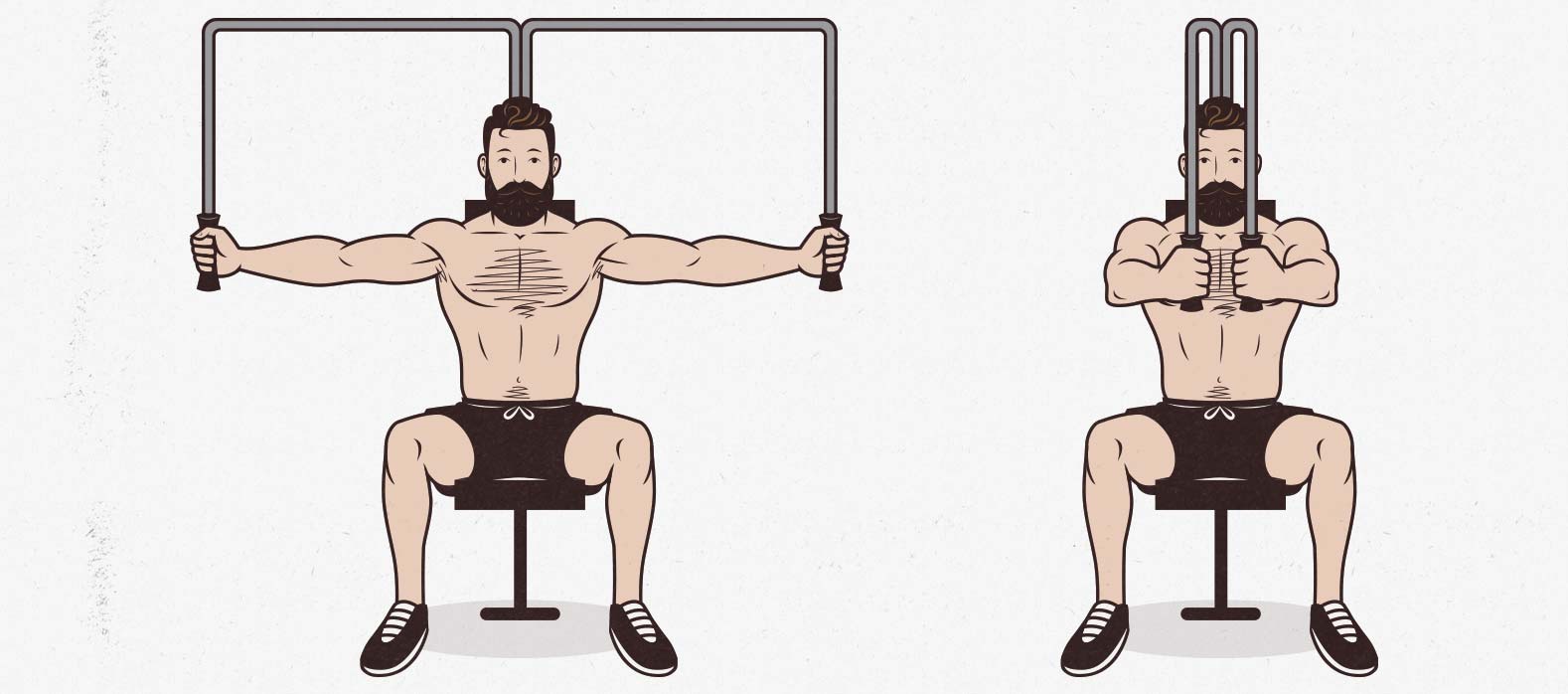
- The setup. Set up the machine so that the starting position fully stretches out your pecs. If you have good mobility in your shoulders, your elbows will be slightly behind your torso. Just like with the dumbbell fly, use a small back arch and drive your shoulders into the bench behind you.
- The lift. With your chest fully stretched, start the lift by squeezing the bars together with your chest (1–2 seconds).
- The pause. Pause for a second with your pecs fully contracted.
- The lower. Lower the weight slowly and under control (2–3 seconds).
The Cable Crossover
Like the machine fly, the cable fly also puts constant tension on your chest throughout the entire range of motion. The difference is that the path isn’t fixed, which adds extra work for your shoulders, making it harder to work your chest. The bigger problem, though, is that the cable fly tends to be easiest at the bottom when your chest is stretched and harder at the top when your chest is contracted. That’s not ideal for building muscle (meta-analysis):
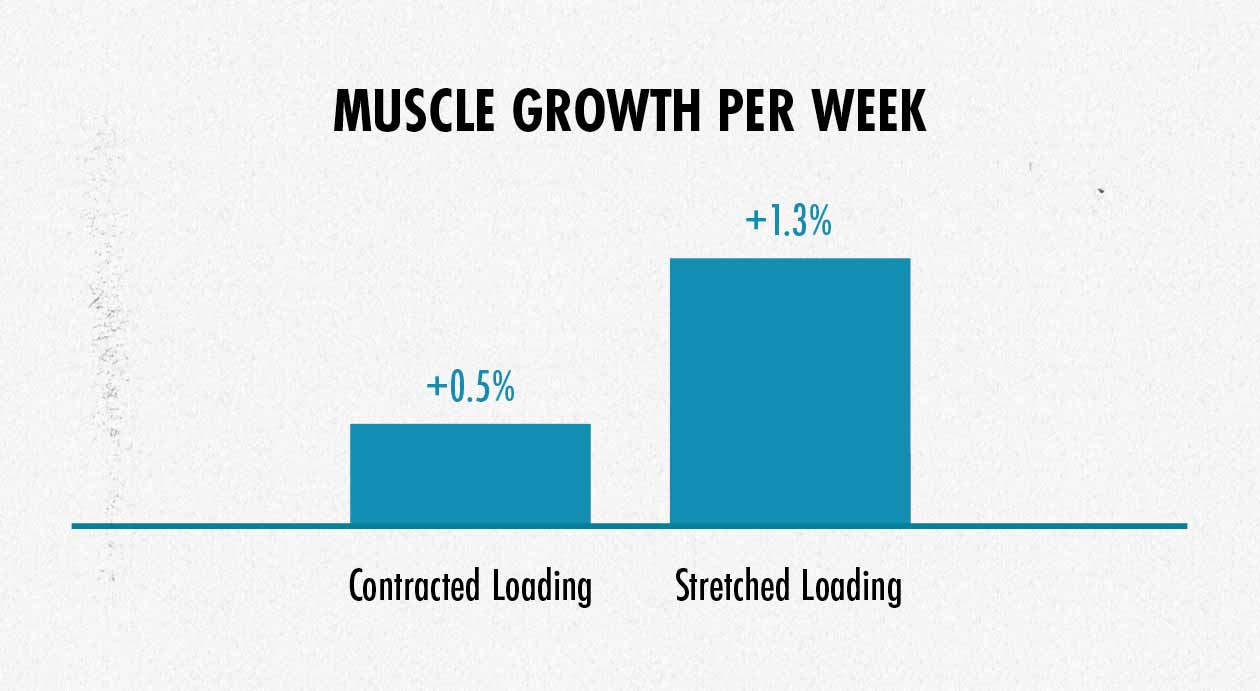
So, if you can, I’d choose the machine fly or dumbbell fly over the cable crossover. But if you prefer the cable crossover, it’s still a good variation for working your chest. Plus, some experts believe that it’s wise to mix lifts that challenge our muscles in a stretch position (such as the bench press) with lifts that challenge our muscles in a contracted position (such as the cable crossover). I haven’t seen any evidence of that, but it’s not totally implausible.
How to Do the Cable Chest Fly Exercise
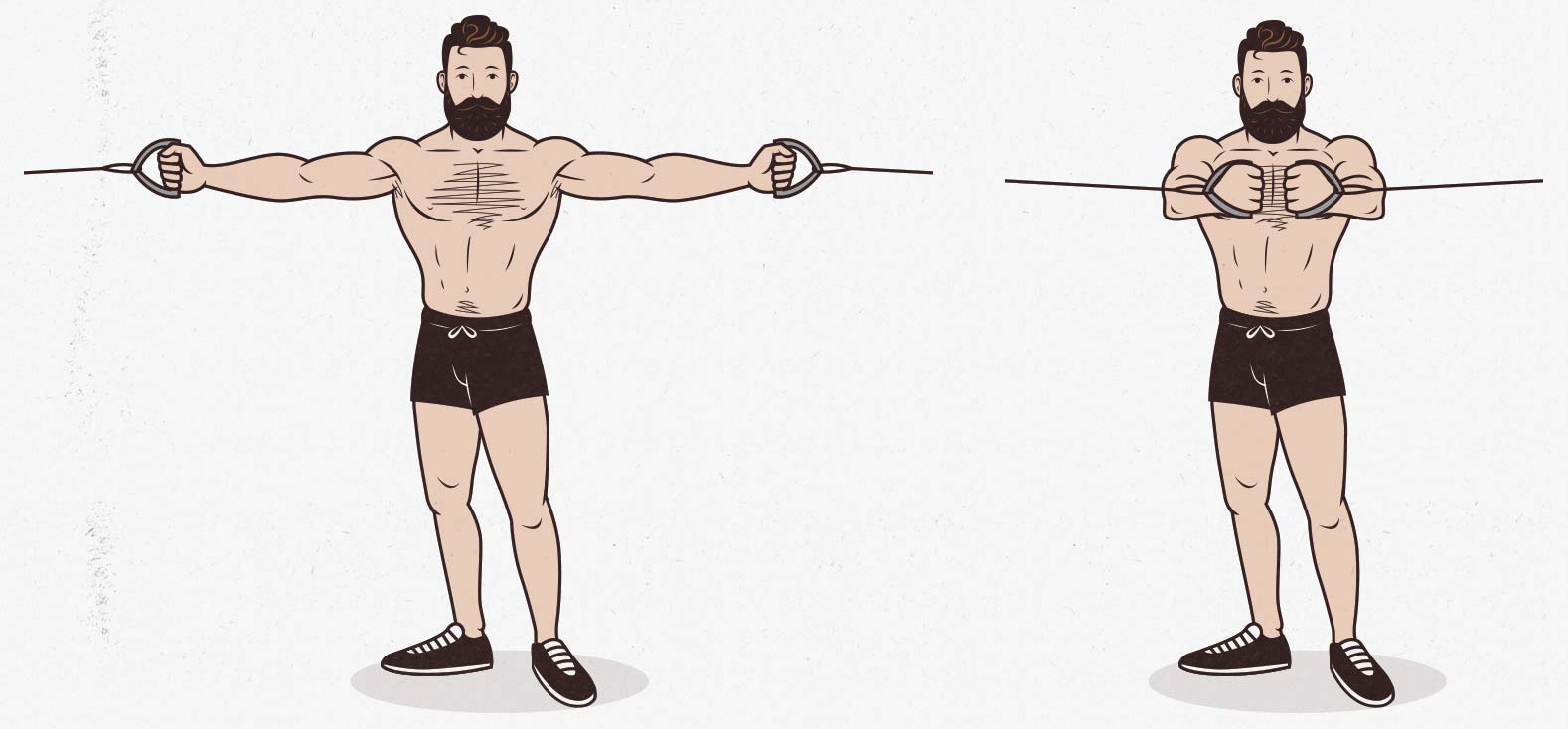
- The setup. Set yourself up between two cable stacks and ensure that your chest is fully stretched in the starting position.
- The lift. Bring your hands all the way together, focusing on feeling the contraction in your chest (1–2 seconds). You can let your hands rotate as you do this, either keeping them facing one another or rotating your palms down towards the floor—whichever feels better and allows you to lift more weight.
- The pause. Pause for a second with your chest fully contracted.
- The lower. Lower the weight slowly and under control (2–3 seconds).
The Best Upper Chest Exercises
Some people can build a lower chest without much of a problem, but they find their upper chest lags. This can happen because they’re doing lots of flat bench pressing with a wider grip. The wider the grip, the more the lower and mid-chest will activate, and the less the upper chest will get involved. The upper chest can also lag from using a dramatic back arch when doing the bench press, essentially turning it into a decline bench press.
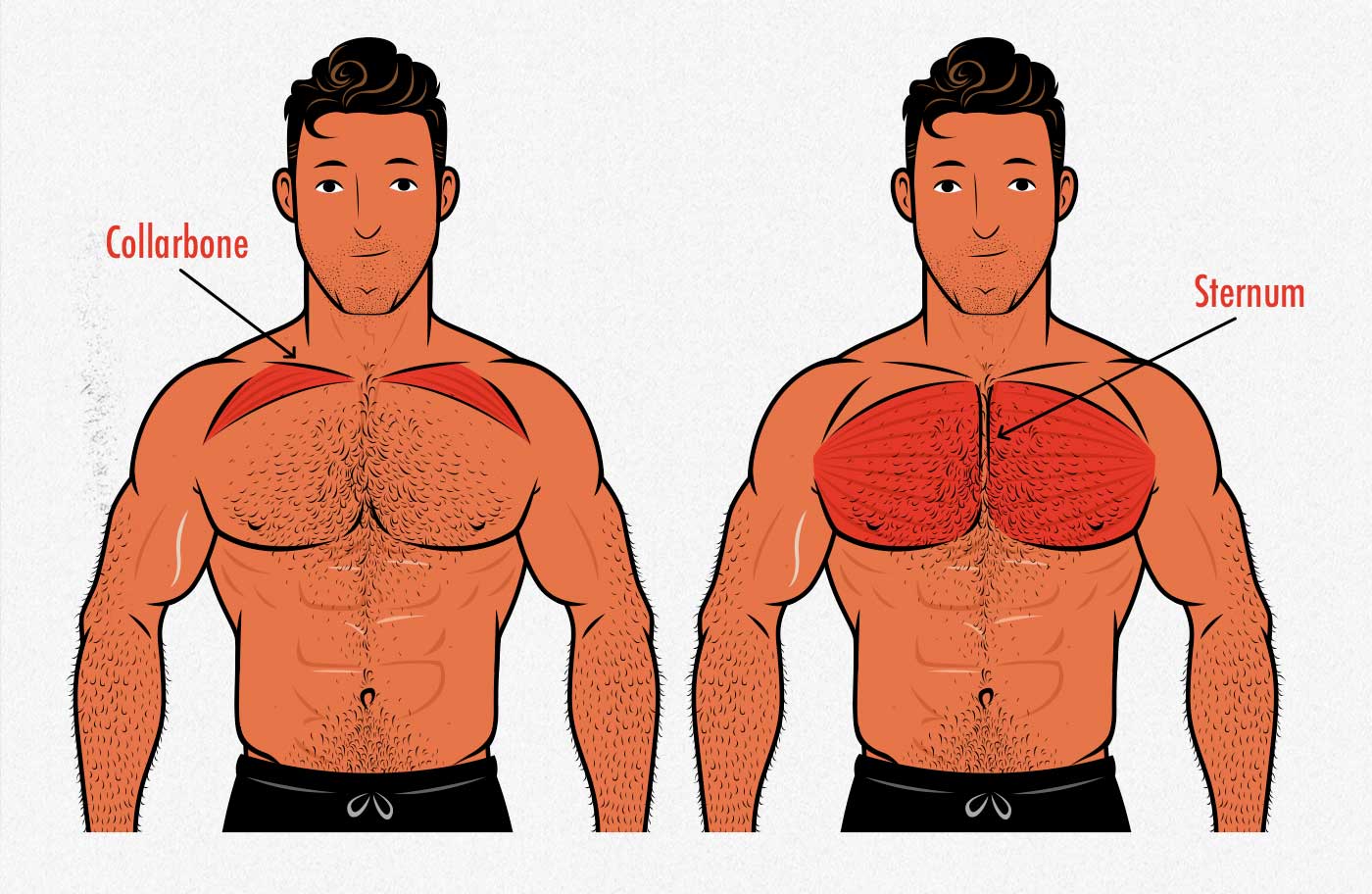
It’s worth noting, though, that the upper chest is almost always quite a bit smaller than the lower chest. There are fewer muscle fibres that connect to our collarbones, giving that area of our chests less growth potential. There are some exceptions, but if your lower chest is bigger than your upper chest, that isn’t necessarily a problem; it’s often just how we’re built.
There are a few good ways to build a bigger upper chest:
- Bench with a narrower grip. The close-grip bench press is great for that.
- Bench on a low incline. The incline dumbbell bench press is great for that.
- Use a low-to-high cable fly. The problem is, similar to the cable crossover, the strength curve isn’t perfect.
Let’s go over all three options.
Low-Incline Dumbbell Bench Press
When we do the barbell bench press on an incline, it’s easy for our shoulders to take over. Keeping the incline low—to around 30 degrees—can help, but even so, it often becomes a shoulder-dominant lift. To solve that problem, we can use dumbbells. With the dumbbell incline bench press, your upper chest needs to not only lift the weights up but also hug them together, adding in a chest fly movement.
With that said, if all you have is a barbell, that’s no problem. Just keep the incline low. Worst case, you wind up building bigger shoulders.
How to Do the Incline Dumbbell Bench Press
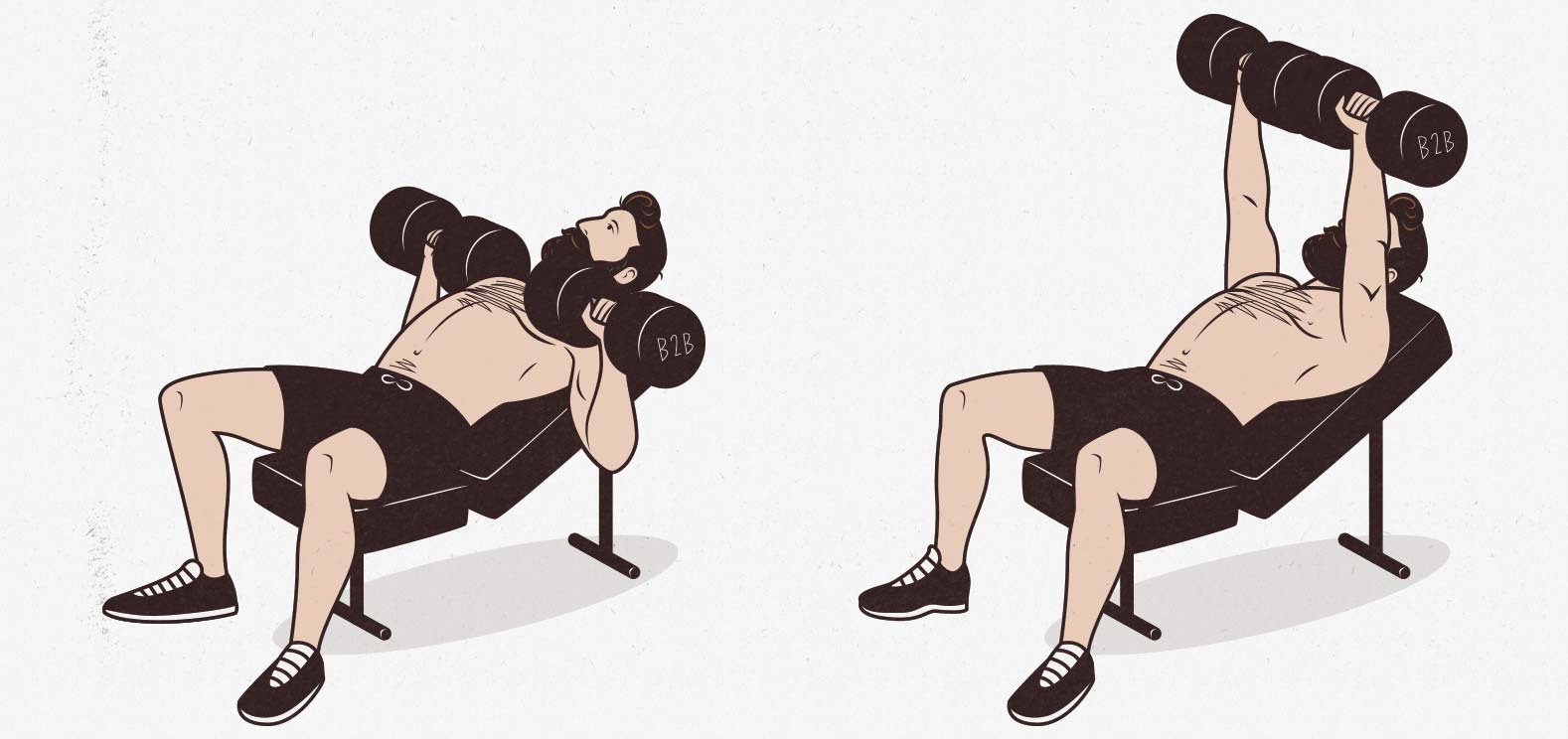
- The Setup. There are two tricks to ensuring that the incline bench press targets your upper chest. First, set the angle of your bench to 30–45 degrees. The steeper the angle, the more you’ll transform the incline bench press from a chest exercise into a shoulder exercise (study). Second, if you tuck your elbows to around 45 degrees, the range of motion will line up better with the line of pull of your upper chest muscles (study). Other than that, use the same setup as the regular bench press: keep your feet firmly planted, your back firmly arched, and your shoulder blades driven down into the bench.
- The lift. Lift explosively, trying to accelerate the dumbbells.
- The lower. Lower the weight under control, neither rushing nor dawdling, until your chest is fully stretched out.
Incline Bench Press Variations:
The barbell incline bench press: the barbell variation is a better choice if you’re using lower rep ranges, as it’s easier to get heavy weights safely into the starting position. It’s also a bigger compound lift, and it does a better job of working your triceps.
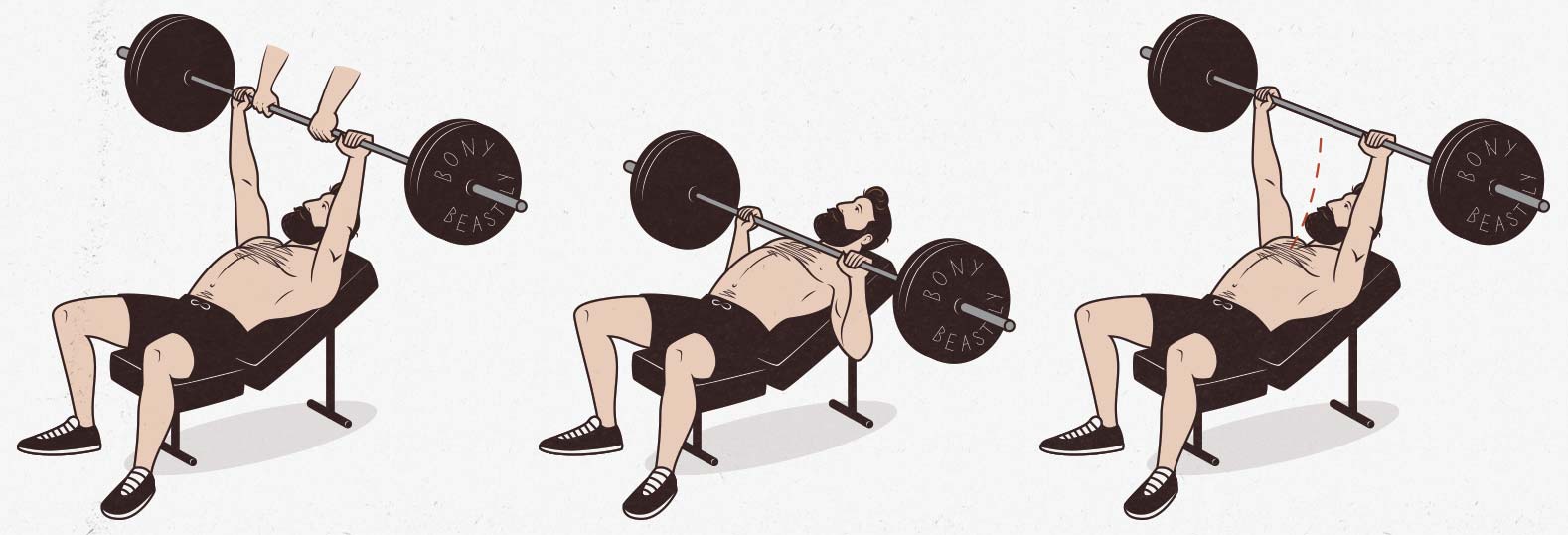
Also, keep in mind that you can vary the incline. Spend a few weeks training at 20 degrees, then another few weeks training at 30 degrees, and then another few weeks training at 45 degrees, stimulating your upper chest and shoulders in slightly different ways.
The Low-to-High Cable Fly
Many experts argue that the low-to-high cable fly is the best isolation exercise for your upper chest. With this exercise, you’re lifting perfectly in line with your upper chest muscle fibres, with the cable stacks putting constant tension on them throughout. I think that may be misguided, as the exercise is less stable and puts less tension on our upper chests at the deeper part of the range of motion. But even so, it remains popular, and it does work.
This exercise works best with higher rep ranges and lighter weights. Practice developing a mind-muscle connection, and use this as the pump exercise for your upper chest, lifting more slowly and keeping constant tension on your upper chest muscles.
How to Do the Low-to-High Cable Fly for Upper Chest Growth
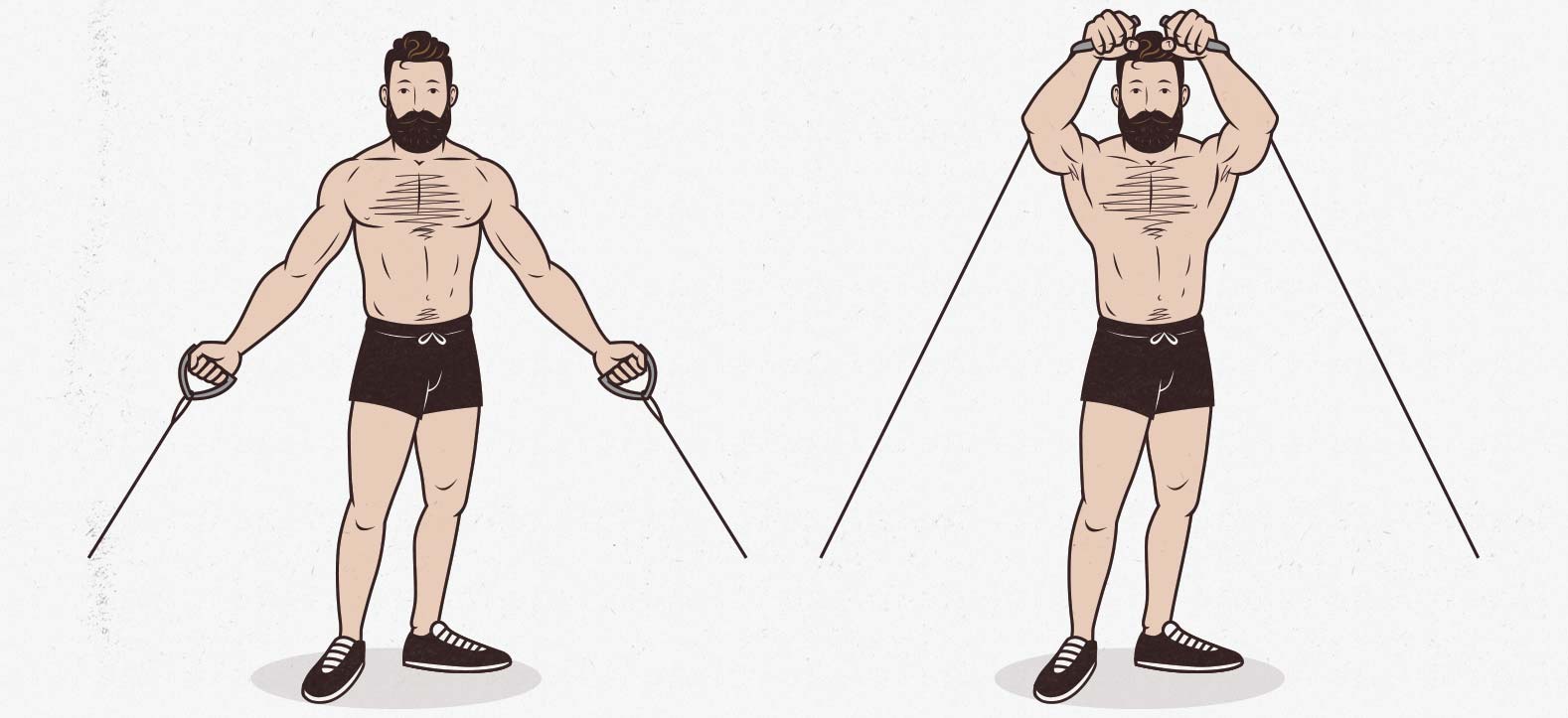
- The setup. Set up a cable stack on either side of you, putting them in their lowest positions. Use a staggered stance for extra stability. Stand in front of the cable stacks with your arms drifting slightly behind your body, stretching out your upper pecs.
- The lift. Squeeze your upper chest muscles to bring your hands up over your head. As you do this, rotate your hands freely. You may be able to get more power out of your upper chest by rotating your hands to face downwards at the top of the lift.
- The lower. Lower the weight down slowly while keeping tension on your upper chest. To get an even fuller stretch on your pecs, you can rotate your hands outwards at the bottom of the lift.
The Best Lower Chest Exercises
The lower chest is quite big and strong, and it will give you great chest definition when viewed from the front. The bench press is great for building a big lower chest, so it’s less common for it to lag, but it can still help to have some lower-chest exercises in your workout routine.
Weighted Dips
Weighted dips are a heavy compound exercise where the pull angle aligns perfectly with the muscle fibres in your lower chest. More importantly, dips allow us to challenge our chests in a fully stretched position, making them great for stimulating muscle growth.
An extra benefit is that, similar to push-ups, your shoulder blades aren’t retracted during the lift, giving you some extra range of motion at the top of the push—great for your chest as well as your serratus anterior muscles.
Note for beginners: Dips require quite a lot of shoulder strength and stability to do safely, making them a fairly advanced lift. If you’re new to lifting or you’ve got cranky shoulders, save these until you can comfortably do all of the other exercises on this list.
How to Do Weighted Dips
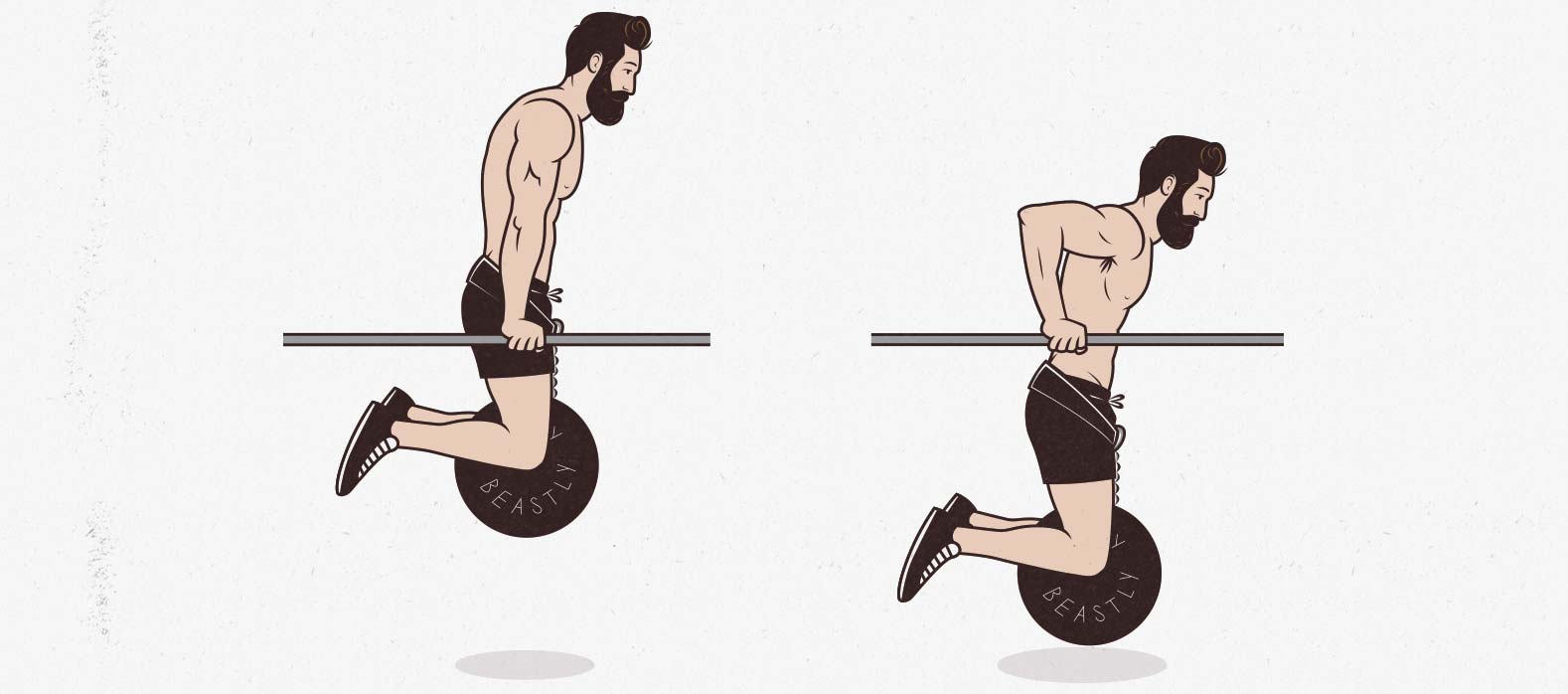
- The setup: To put more emphasis on your chest, lean forward a little bit and bend your knees, letting your feet drift back. This little bit of a lean over the bar will ease the load on your triceps and bring in your lower chest.
- The lower: To put more emphasis on your chest, let your elbows flare out to the sides a little bit as you go down, and lean forward instead of keeping a totally upright torso. Lower yourself until you’ve got a full stretch on your lower chest (or until your shoulders get cranky), keeping your forearms as vertical as possible.
- The lift: Push yourself back up to the starting position, flexing both your chest and your armpits at the top of the lift. This slightly increases the range of motion for your pecs and stimulates your serratus anterior muscles.
Dumbbell Pullovers
Pullovers are the only exercise on this list where you’re pulling your arms back towards your torso instead of pressing them out. That allows you to stimulate your chest muscles in a new way, helping you build rounder and fuller pecs. This makes them a popular chest exercise among bodybuilders (and they’re another favourite of Arnold Schwarzenegger). They’re also another one of those lifts where most of the tension is when your chest is under a deep stretch. These lifts tend to be best for building muscle.
The question is, do pullovers actually work our chests? Or do our lats do all the work? According to the EMG research of Dr Bret Contreras, pullovers do stretch our lats out at the bottom of the lift, but then the tension quickly dissipates, shifting the majority of the load to our chests. So while these aren’t a mandatory chest exercise, they offer you a novel way to stimulate the muscle fibres in your chest, which may help improve your chest size and appearance.
How to Do Dumbbell Pullovers for Chest Size

- The setup. Put a dumbbell at the top of the bench to grab later, then rest your back sideways on the bench, forming a cross. This cross position allows you to either drop your hips for a greater stretch or keep your butt and abs tight for a better core workout. As shown above, we recommend bracing your core, as it translates better to your other lifts. Grab the dumbbell from beside you with both hands, as shown in the illustration.
- The lower. Slowly lower the weight back behind you until both your pecs and lats are fully stretched (or until your shoulders protest).
- The lift. Bring the weight up by focusing on squeezing your pecs. It’s okay if your lats or triceps chip in, but try to get your chest doing most of the work.
How Many Chest Exercises Should You Do Per Workout?
To build muscle, it’s best to train our muscles with 3–8 sets per workout, with some research showing that doing as few as 5 sets per workout is enough to maximize our rate of muscle growth. So that means that for your chest, doing just 1–2 chest exercises per workout is enough.
Now, the catch is that you need to work your chest hard enough to stimulate muscle growth, which usually means bringing it within 0–3 reps of muscle failure. So if the strength of your chest doesn’t limit you, your chest might not be worked hard enough, and you might not get a maximal growth stimulus out of it. For example, if the bench press works your shoulders and triceps harder than it works your chest, then even if you bring your set all the way to failure, it might still not fully work your chest. In that case, you might want to follow it up with a lift that is limited by the strength of your chest, such as a chest fly.
If you get great chest activation and soreness from the bench press, doing 3–5 sets of the bench press should be enough to maximize your chest growth. But if the bench press isn’t fully working your chest, consider adding in another 2–4 sets of a chest isolation lift.
How Often Should You Train Your Chest?
Most research shows that training our muscles 2–4 times per week is ideal for building muscle (meta-analysis). The bigger your chest is and the harder you train it, the longer it will take to recover, and so the more days you’ll need to wait between workouts.
As a beginner, a good strategy is to train your entire body 3 times per week, including 1–2 chest exercises every workout. That way, your chest is growing steadily throughout the week. As you get more advanced, you may find that you prefer to train your chest just twice per week. That was certainly the case with me. As a beginner, I saw my best chest gains by training my chest at least a little bit every workout. Later on, when going from a 265-pound to a 315-pound bench press, I was only benching twice per week.
Summary
The best chest exercises are the ones where our chests are the limiting factor, our chests are worked through a deep range of motion, and our chests are maximally challenged at long muscle lengths. Fortunately, that gives us a list of fairly classic chest exercises:
- The Barbell Bench Press: this is the best chest exercise, and it’s a great compound lift for your shoulders and triceps, too. Use a moderate or wide grip, bench deep, and do at least 9 reps per set.
- The Dumbbell Bench Press: if you have trouble feeling your chest working during the barbell bench press, and if it doesn’t leave your chest feeling sore afterwards, the dumbbell bench press is a great alternative. It does an even better job of emphasizing your chest, albeit at the cost of your triceps.
- The Deficit Push-Up: this is the best bodyweight chest exercise, and it’s just as good as the bench press for bulking up your chest. The only downside is that it’s harder to add weight to it. But until you can do 30 repetitions, that isn’t a problem—you can fight to do more reps.
- The Chest Fly: this is the best chest isolation exercise to pair with the bench press or push-up, either as a follow-up exercise or as a superset. Doing the chest fly with dumbbells or on an exercise machine is probably ideal for stimulating muscle growth, but some prefer cable crossovers, and that’s okay.
- The Close-Grip or Incline Bench Press (upper chest). These are the best lifts for building a bigger upper chest. Both are great, so choose the one that you prefer.
- The Weighted Dip: like the push-up, the dip is an amazing bodyweight exercise for your chest. However, it often benefits from being loaded heavier, making it better for people who have a dip belt.
- The Pullover: this is a great exercise for working your chest through a deep overhead range of motion, making it quite different from the other chest lifts. Muscle-activation research confirms that it’s good at stimulating the chest, and because it’s hardest at the deepest part of the range of motion, it should be quite good for building muscle.
These lifts will give your chest all of the stimulation that it needs to grow. At that point, it will all come down to eating enough protein to build muscle, eating enough calories to gain weight, and getting enough good sleep. That way, you can show up to your next workout bigger and stronger, allowing you to lift even more weight. That’s how you’ll build a bigger chest.
If you haven’t gained your first twenty pounds of muscle yet, I think you’d love our Bony to Beastly Program. It’s a 5-month bulking program made up of 3 full-body workouts per week, each containing a couple of chest exercises. It will help you build muscle overall, including a bigger chest.

But if you’re a seasoned lifter who’s already gained at least twenty pounds, or if your chest is stubbornly lagging behind the rest of your muscles, then you might like our chest specialization program: War Chest. It’s a full 50-page guide, including an 18-week periodized chest workout program—all of it designed to get you as much chest growth as physically possible. Every muscle group will be worked, but there’s a huge emphasis on helping you build up a truly massive chest.
Shane Duquette is the founder of Outlift, Bony to Beastly, and Bony to Bombshell, each with millions of readers. He's a Certified Conditioning Coach (CCC), has gained 70 pounds, and has over a decade of experience helping more than 15,000 people build muscle. He also has a degree in fine arts, but those are inversely correlated with muscle growth.
